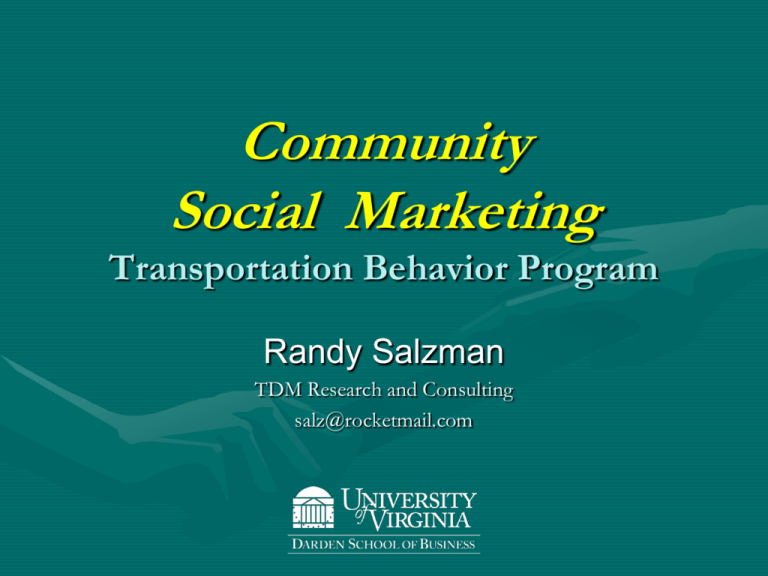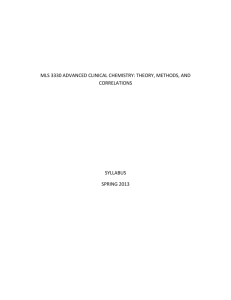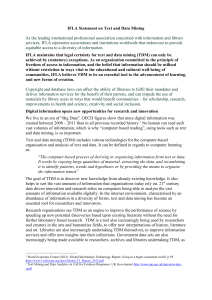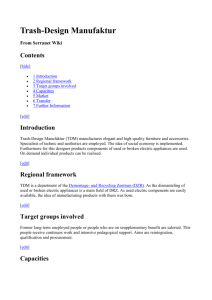Richmond Presentation
advertisement

Community Social Marketing Transportation Behavior Program Randy Salzman TDM Research and Consulting salz@rocketmail.com Why America Must Address Driving Behavior • Drive 2.9 trillion miles/year in 411 billion trips, 87 % alone • Produce 45 percent of entire world’s automotive CO2 • Transport creates more greenhouse than other economic sectors • And uses 70 percent of U.S. daily 19 million barrels of oil • Two-thirds imported • Creating national oil spill, congestion, pollution externalities • While our nation gets fatter and less healthy • And the world believes we will spill “blood for oil” USDOT, Texas Transportation Institute, U-Mass Center for Transportation, Pew Charitable Trust But Our Culture Supports Driving • Advertisers seek the child market because, once hooked, he or she rarely changes behavior • ‘Engravings on brain’ • The ‘license’ is a right of passage • Car perceived of as ‘freedom’ • The film hero always drives a ‘hot’ car • Media is supported by car advertising dollars and product placement • Media editors, bloggers, writers, designers, actors are all drivers • Politicians cater to driving voters To hold annual congestion loss at $87 billion, 4.2 billion hours, must build over 16,000 highway miles annually Global Warming, Peak Oil, Health, Congestion, Foreign Policy, Parking, Space, Safety and Land Use Need individual transport behavioral change… …in the short term …on a massive scale …with little institutional power …in a culture prizing individuality …with generally poor substitutions …which often require decades to build Paradoxes • Drivers underestimate time/cost of car. Overestimate time/cost of alternatives • Congestion caused by habitual, local driving. Complex, multi-jurisdictional results • Building roadways to fight congestion induces more traffic • Voters react primarily to congestion. Politicians can’t be seen to be ‘attacking’ driving voters • Alternative transportation ‘stated preference’ unreliable. Yet seek ‘stated prefer’ data for funding Alternative Mitigation “Soft” Transportation Demand Management • “Hard” – make people pay to drive • “Soft” – incentivize & educate them w/Why & How to use alternatives • TravelSmart worldwide successfully getting drivers out of single occupancy vehicles • Bottom Line: Soft TDM is best approach to altering driving behavior in wide-open-space democracy How America does TDM today • Commute-oriented, “benefits day” handouts, CDs, web pages – Must “drive to” media • But commute trip hardest to change • Generally, promoted by employer’s low-level, human resource personnel • With scant public backing, usually youngest planner on regional planning district staff • Emphasis on time and dollar savings of using alternative commute modes Better TDM Community Social Marketing • Still employer based – tied to existing American TDM 1. Save on parking, long-term health costs 3. Connect well-known problems like global warming, oil dependency 4. Doesn’t “threaten” potential voters or employees • Underscored by Psychology, Marketing, Leadership and Consumer Behavior data • Utilize consistent, simple corporate message • Best: “Carrots, Sticks AND Tambourines” Community Social Marketing TDM Discuss auto ‘externality’ issues w/staff at monthly department/division meetings. Socially market driving issues in short, five-minute segments (one issue/externality each meeting) led by “know-nothing” upper management 1. Illustrates organization leaders behind “right thing” • Upper management follows short basic script 2. Allows “framing” discussion • Max 10 slides keeps upper management directing info flow 3. Eliminates off-message questions • “Keep meeting short for department’s benefit” 4. Allows monthly reiteration of same, simple “right thing” message • “The organization cares. Hope you do too” 5. Reinforces “changers” • Assures them they made right decision Social Marketing Health Externality Discussion Greatest potential for organizational health benefits accrue if sedentary adults begin regular, moderate activity • Like walk to transit stop daily • Or daily active transportation • Doctors prescribe walks today • Business: Every $ spent on fitness returns $3.15 in health benefits • Fit: Average 3-5 less sick days • Some employers pay bonus for fitness -$7 to $14 per percentage/#pounds lost Community Dialogue Marketing TDM Monthly ask employees after social marketing/externality discussion if want more info or consider another transportation mode Sign each individual up for dialogue marketing • • • • • Allows work with only employees most likely to address habit while reminding mass of behavioral change need Allows bypass/isolation of advocates for auto lobby Builds towards individual and corporate “tipping point” Similar to ‘TravelSmart’ but employer-solution focus No one is coerced Dialogue Marketing TDM Have knowledgeable advocate individually market that employee with data and rewards for attempting other commute styles Akin to Australia’s “TravelSmart” program 1. 2. 3. 4. 5. Western Australia: 135,000 families targeted in 2008, as many as 12 personal contacts each, total of 418,000 households since 2000 Leadership support, from a distance All demographics – especially professionals – utilize alternative transportation In Brisbane, undergoing $22.6 million project to market 324,000 households About $70 per household With social marketing, nudges the mass as well as quickly gathers “low hanging fruit” Dialogue Marketing In every Aussie city except Sydney • Perth: Have annual 13-percent reduction in car-miles driven 30 million less car trips with 88,000 tons less greenhouse gas annually • 27-percent increase active/muscle-powered transport 7 million more hours of physical activity annually from 9 million more walking trips & 4 million more cycling trips (up 58 percent) • Stronger neighborhoods (Norman Rockwell effect) • Perth: Transit boardings up 4.2 million annually. 48 percent return on investment annually. • 67:1 benefit-cost ratio – (auto projects 4:1) • Adelaide: GPS study found 18 percent reduction in KM driven. • Brisbane: Seeking diffusion, duration, carryover research in 324,000 home project – no health or political effect data – after 70,000 home project found 60 percent diffusion rate. Perth opened new commuter rail in December 2007 90% approval ratings, 67,000 first-day riders. Brisbane building huge bike/ped and busway system. Dialogue Marketing Western Australia Decade later Perth – a city of suburbs and freeways -- expanded TravelSmart concept to individually, dialogue market citizens Energy, Water, Recycling Originally, ¾ citizens didn’t want marketing. Today, 80 percent desire hearing how to change own behavior. “People want to be part of the solution. They just don’t know how.” Brög, TravelSmart founder, 2007 Long Term Results • Adelaide, 3-year GPS project. Drivers traveling average 12.4 FEWER miles per day after TS marketing • TS credited with re-vitalizing transit in Western Australia, Queensland and Victoria • Both Conservative and Liberal politicians love “tax dollars at work” letters marketed to solely people who care • Brisbane built two, $6.5 million “end of road” cycle centers, budgeted $100 million in bike-ped trails, considering downtown lanes for Bus Rapid Transit, opened fourth busway in 2009 • Several communities placed political ban on road building • Fed 2010 budget: 55% to transit -- 80% to highways in US Australia Expanding Rapidly “Given the findings to date, the number of evaluations undertaken, and their consistency, Australia is now in a position to move beyond piloting TravelSmart to engage in large-scale interventions in all major metropolitan and large regional centres. “There is little further need to undertake major evaluations of household projects, as the Australian and international data is in broad agreement, and there is little need to demonstrate the effectiveness of methods used.” Report to the Department of Environment: Evaluation of Australian TravelSmart Projects in the ACT, South Australia, Queensland, Victoria and Western Australia: 2001–2005 Dialogue Marketing TDM • Discover transportation/commute needs Constantly tailor substitutions and adapt due to on-going “action” research • Solve disincentives; Create incentives to mode change • Show options: Hike, bike, car-van pool, transit, telecommute Bus schedule from nearest stop; Perhaps free pass Bike shop discounts Walk/bike maps, discounts for walking shoes Actively connect employees working similar hours • Emphasize guaranteed ride home program • Emphasize “occasional parker” programs • Emphasize flex car possibilities Present Opportunity • Administration seeking “Livable Communities” projects which tie transportation to global warming, oil vulnerability and neighborhood development • Research dollars available, as well, from CDC, Robert Wood Johnson Foundation, Rockefeller Foundation • FHWA now seeking unique concepts in its “Nonmotorized Transportation Pilot Program” • EPA now seeking “Climate Showcase Communities” w/dollar grants and technical support Human Behavior Concepts Nudge Thaler & Sunstein, 2008 The Tipping Point Gladwell, 2000 Fostering Sustainable Behavior Mackenzie-Mohr & Smith, 1999 Changing Minds Gardner, 2004 Psychological Needs and the Facilitation of Integrative Processes Ryan, 1995 Why We Do What We Do Deci & Flaste, 1996 Randy Salzman salz@rocketmail.com Community Social Marketing Transportation Behavior Program Randy Salzman TDM Research and Consulting salz@rocketmail.com Community-based Marketing Change inevitable but most resist change Self-Determination, Autonomous Decision Success “Autonomous choice requires a decision that is accompanied by the experience of endorsement and willingness.” Deci, Why We Do What We Do Seven Tools to Change Minds Reason: Research: Resonance: Representational ReDescriptions: Resources and Rewards: Real World Events: Addressing Resistances Gardner, Changing Minds






